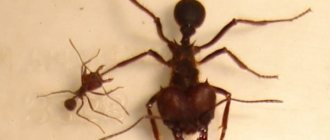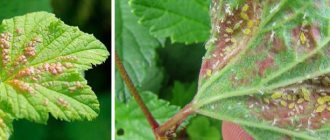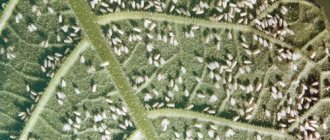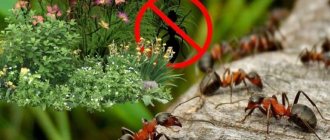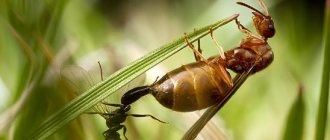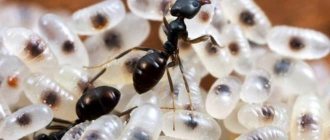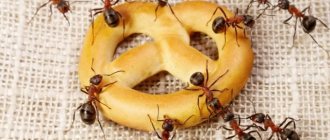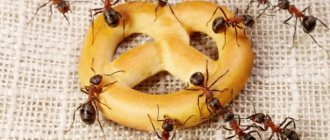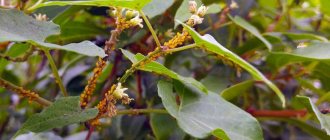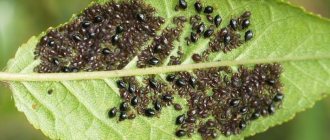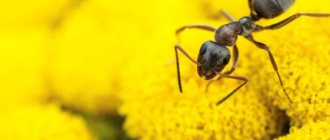The interaction of ants and aphids on garden plants may seem like a pure coincidence to some. In fact, these insects are biologically connected in a very serious and not very pleasant “relationship” for the summer resident. But first things first.
In general, there is an opinion that ants are the most useful insects and one can only be happy about the presence of an anthill on the site, they say, these “orderlies” will exterminate any creeping harmful little thing. But is this really so? Let's take a closer look at the situation.
Lifestyle of aphids
Aphids themselves are small insects, not exceeding a few millimeters in size . Their oval-shaped bodies are covered with a tuberous, half-transparent shell. Thanks to their long legs, aphids can crawl and even jump from one plant to another. Read more about where aphids live and what gardeners and gardeners need to know about the pest here.
They live in colonies, and in each of these colonies there are both wingless insects and individuals with wings. The winged trait in aphids is not related to gender: both females and males have wings. An adult insect has antennae on its head, thanks to which it distinguishes sounds, and it also needs antennae for touch.
The eyes of aphids with a complex multifaceted structure come in different colors : from red to dark brown, almost black. Wingless insects may have three simple eyes in addition to them.
This is interesting! Aphids see better than most other insects, they can even distinguish some colors.
The aphid's mouth opening is a small proboscis consisting of four segments. She uses it to pierce the skin of the plant and suck out the juices from it (you can find out more about what aphids feed on here). The leaves of plants affected by aphids begin to wither, the shoots stop growing, and hollow projections called galls form on the roots. Aphids can infect any part of the plant without exception , which makes it a particularly formidable and dangerous pest.
The life cycle of aphids begins with the female laying eggs in the fall, which hatch into larvae in the spring. Having become adults, they begin to reproduce by parthenogenesis, that is, without fertilization. At this stage, the offspring of aphids are only wingless females. In a month their number can reach hundreds of thousands.
As soon as the colony is overcrowded, among the offspring there appear individuals with wings that can fly to other plants. At the end of summer, winged males appear among the offspring of aphids .
When they become adults, individuals of both sexes participate in reproduction. The female now lays much fewer eggs. But fertilized eggs will be able to survive the winter, while all aphids hatched from the first, unfertilized clutches do not survive until the cold weather.
Aphids can live from several days to a month . Cool temperatures, 8-10 °C, extend the life of the female to two months.
Reasons for the appearance of pests on the site
Ants and aphids in the garden (they must be dealt with immediately, otherwise they can destroy most of the crop) may not affect the fruits, but due to their presence, the tree begins to lose vitality.
As a result, the crop becomes more susceptible to fungal and viral infections. Afterwards the plant dies.
The reasons for the appearance of aphids on the site may be the following factors:
- failure to comply with preventive procedures related to plant treatment;
- transfer of aphid larvae by people, animals or wind;
- planting crops that were previously infested with insect pests.
The reason for the appearance of ants on bushes and fruit trees is an invasion of aphids. The ants live near the parasite in order to collect a sweet sticky liquid, which they eat themselves and give to the queen and the larvae. Therefore, to eliminate ants, you must first get rid of aphids.
How do ants live?
Ants belonging to the order Hymenoptera live in nests they build - anthills, located in the ground, under stones or in wood. Often, other insects that have entered into symbiosis with ants live there along with them.
In addition to the host ants, sometimes “slaves” captured by them live in anthills - ants from other colonies who do the hardest work.
Ants are small insects, their numbers are huge because they reproduce very quickly . They live everywhere except Antarctica and several islands lost in the world's oceans.
An ant colony is a complex structure divided into castes:
- Female ants - also called queens or queens - only reproduce. Unfertilized eggs produce males, and fertilized eggs produce females. The queen has wings, but she chews them off immediately after finishing her flight. Ant queens are much larger than their “subordinates” and live longer than them. The lifespan of a queen ant can reach 20 years or more.
- Male ants are smaller than the queen and also have wings. Their only task is to participate in mating. After the males have fulfilled their purpose, they are destroyed by other ants. The lifespan of male ants reaches several weeks.
- Working ants or foragers are females with an underdeveloped reproductive system. They obtain food, maintain order in the anthill and raise future offspring. The largest individuals among the working ants with a large head and highly developed jaws, which are called soldier ants, protect the anthill from uninvited guests.
Ants are considered beneficial insects, but when they settle near humans, they cause considerable harm.
Important! Ants damage garden and vegetable plants, as well as cereals, undermine the inside walls of wooden houses and sheds and help aphids to reproduce unhindered, which makes it very difficult to fight them.
Insect symbiosis: why do they need each other?
Ants bring aphids and place them on the leaves of garden or vegetable crops . By absorbing plant juices, leaf aphids obtain proteins and remove sugars from their bodies in the form of sweet drops called honeydew or honeydew.
What is the essence of the union of insects, how do ants milk the symbiont (aphid) and do they eat it themselves? The ant tickles the aphid with its antennae, and it secretes a drop of sweet liquid. Some aphids secrete a drop of honeydew almost every minute.
For this, the ants herd or protect aphids from ladybugs, lacewings and birds and even build clay shelters for them on plant stems, and also transfer aphids to other, younger and succulent plants after the diseased plant begins to wither.
For the winter, ants even take aphids into their anthills , where they take care of them and the eggs they lay all winter.
About the life of an ant family
Ants are accustomed to living in colonies, the guardians of which are queens. The function of protecting the family is assigned to the soldier ants; the menial work is performed by the worker ants. Their responsibilities include not only caring for the nest, but also collecting food for all members of the family.
It has long been known that arthropods have a sweet tooth. Thus, in a person’s home, insects are often attracted to sugar, sweet fruits, and food waste. Under natural conditions, ants milk aphids using their sweet secretions (honeydew) as food. Therefore, it would be useful for those who love gardening to know which ants breed aphids.
How to fight?
Garden ants settle in summer cottages and garden plots, spoiling the harvest and breeding countless hordes of aphids.
There are many chemical drugs against ants , the main action of which is primarily aimed at paralyzing the nervous system of these insects. Most of them are based on diazinon or chlorpyrifos.
You can fight ants in more “ecologically friendly” ways: spread anise leaves or sawdust mixed with grated garlic around the anthill. Or pour kerosene on it, but do not set it on fire.
Attention! Regular salt gives a good effect: it should be poured onto the anthill itself and the paths along which these insects move.
Wormwood and parsley growing on the site will also protect against ants that do not tolerate the smell of these herbs.
Vegetable oil, tobacco ash, crushed tomato leaves, as well as turpentine and charcoal are also good remedies against them.
But due to the fact that the greatest damage to the garden is caused not by ants, but by aphids, you need to fight them first. There are several ways to do this. The most popular methods of fighting are mechanical or manual . You can also use chemicals that will kill aphids.
You can also plant plants around your garden or garden that attract natural enemies of leaf aphids, such as ladybugs, hoverflies, lacewings and various birds.
Read more about other helpers in the fight against aphids in this material.
Chemicals - application features
Of course, chemicals are considered to be most effective in the fight against arthropods. Chemical agents allow you to get rid of all parasites in one treatment and forget about them by the onset of the next spring season. But it is worth noting that the side effects are quite harmful.
Beneficial insects, as well as the soil, suffer due to exposure to pesticides. It is necessary to exclude the possibility of their use during flowering of vegetation, fruit set, and harvesting.
Let us also note the presence of developed analogues of chemical preparations - they are biologically active agents. The most popular are Akarin, Aktofin, Fitoverm, Biotlin. They have a targeted effect on parasites, excluding harm to the plants themselves, since their composition does not contain chemicals or toxic ingredients.
How to protect trees?
Tree protection can be done in several ways:
Place trapping belts made of several layers of corrugated cardboard or plastic film on the tree trunks, tying them in two places with soft rope and applying a strip of grease along the perimeter in the central part.- Dig a shallow hole around the perimeter of the tree and place a car tire cut in half and filled with water in it.
- Rub the tree trunks with garlic arrows, the smell of which ants cannot stand.
- Wrap wormwood grass or tomato tops onto the boles.
- Contact the nearest SES to have pest control specialists treat the trees themselves, as well as nearby plantings and anthills.
The reader may find useful information about the fight against aphids that live on various plants, both at home and in the garden:
- How to get rid of aphids on orchids at home?
- How to get rid of aphids on peppers?
- What to do if there are aphids on roses?
- How to control aphids on fruit trees?
- How to fight aphids on cucumbers?
- How to effectively fight aphids on currants?
- How to deal with white aphids on indoor and garden plants?
This type of relationship, such as the symbiosis between ants and aphids, has existed for millions of years - these insects depend on each other so much that they could not survive alone. If aphids appear on the site, it is necessary to simultaneously fight against both of them. If you do not fight not only aphids, but also ants, then the leaves of the plants will very soon again be covered with these harmful insects.
If you find an error, please select a piece of text and press Ctrl+Enter.
Basic ways to combat invasion
The ants involved in breeding and dispersing aphids will leave after the disappearance of the “breadwinners”. Therefore, it is recommended to destroy smaller insects first. If you manage to get rid of these pests, the ants associated with them will also leave the area.
Ways to fight:
- Mechanical. It involves collecting pests by hand. This is painstaking and difficult work, but it allows you to sharply reduce the number of individuals and prevent their uncontrolled reproduction.
- Planting plants with a pungent odor. To prevent aphids from entering the garden, it is necessary to plant onions or garlic around its perimeter. Insects cannot tolerate the aroma emitted by these plants, so they will go looking for areas with more favorable conditions.
- Attracting natural enemies. The aphids that eat the most are ladybugs, lacewings and hoverflies. In order for these insects to settle on the site, it is necessary to plant nettles or any herb on it. At the same time, you should not take plants with a pungent odor, as it can scare away welcome guests.
- Attracting tits and sparrows. You can achieve the appearance of these birds in the garden where the pest has settled by feeding them with seeds or lard.
Ants are much more difficult to fight than aphids. To remove these insects, it is best to use chemicals. They paralyze the nervous system of the pest and lead to the death of most of the colony.
Important! When using chemicals, children and pets should not have access to the area.
Among the more humane methods are the following:
- Sawdust with grated garlic. This mixture is spread around the anthill. Insects pick up on the unpleasant odor and quickly move to a new location. Anise leaves have a similar effect.
- Salt. This food additive should be sprinkled on anthills and insect paths. Pests do not tolerate this substance, so they quickly leave the area.
- Sagebrush. This plant is planted around the perimeter of the garden. Its aroma spreads over several hundred meters, driving away any pests.
